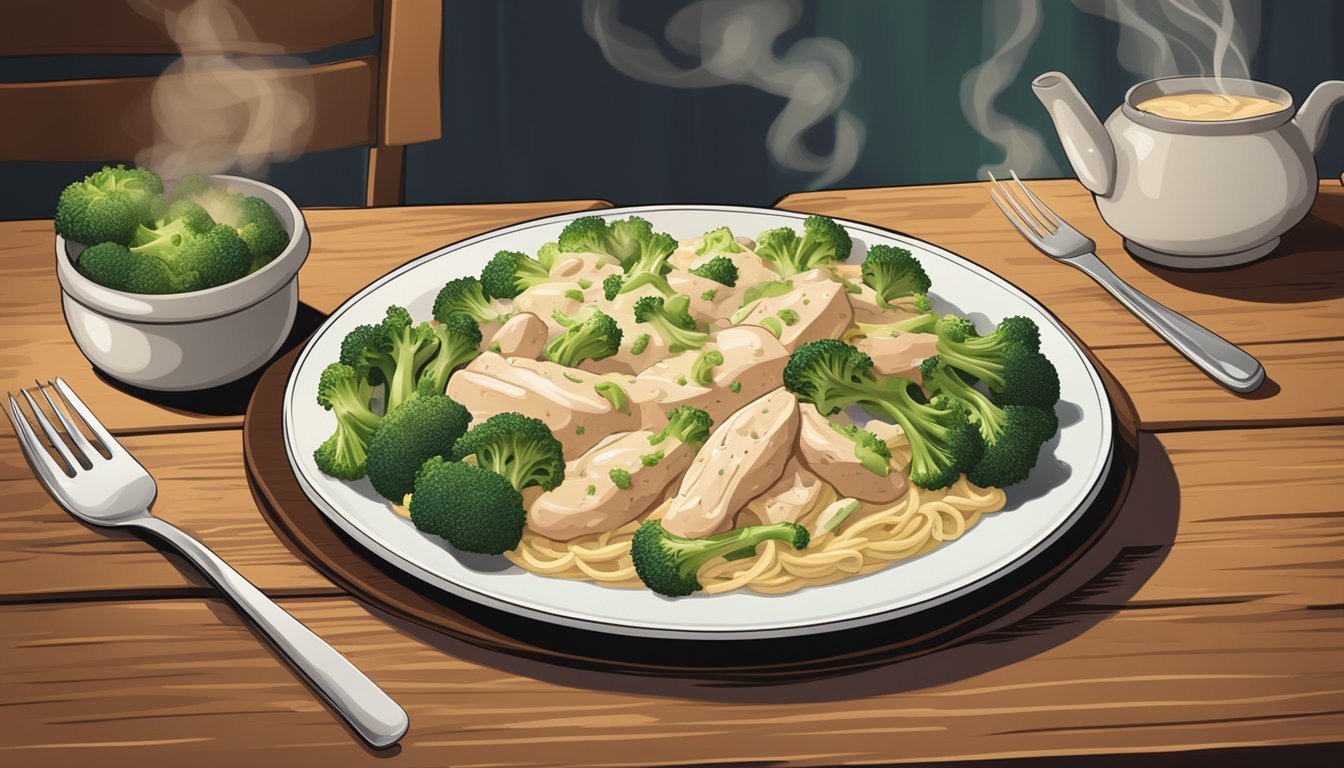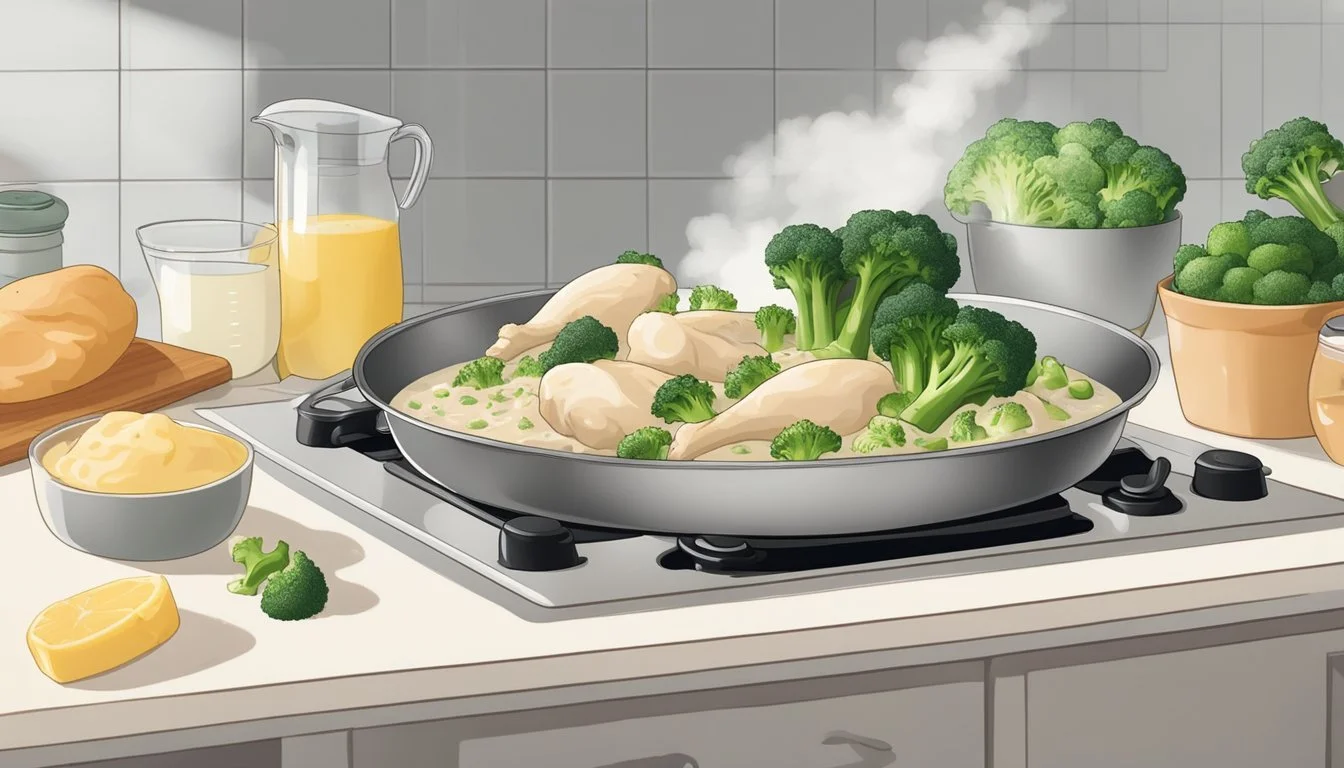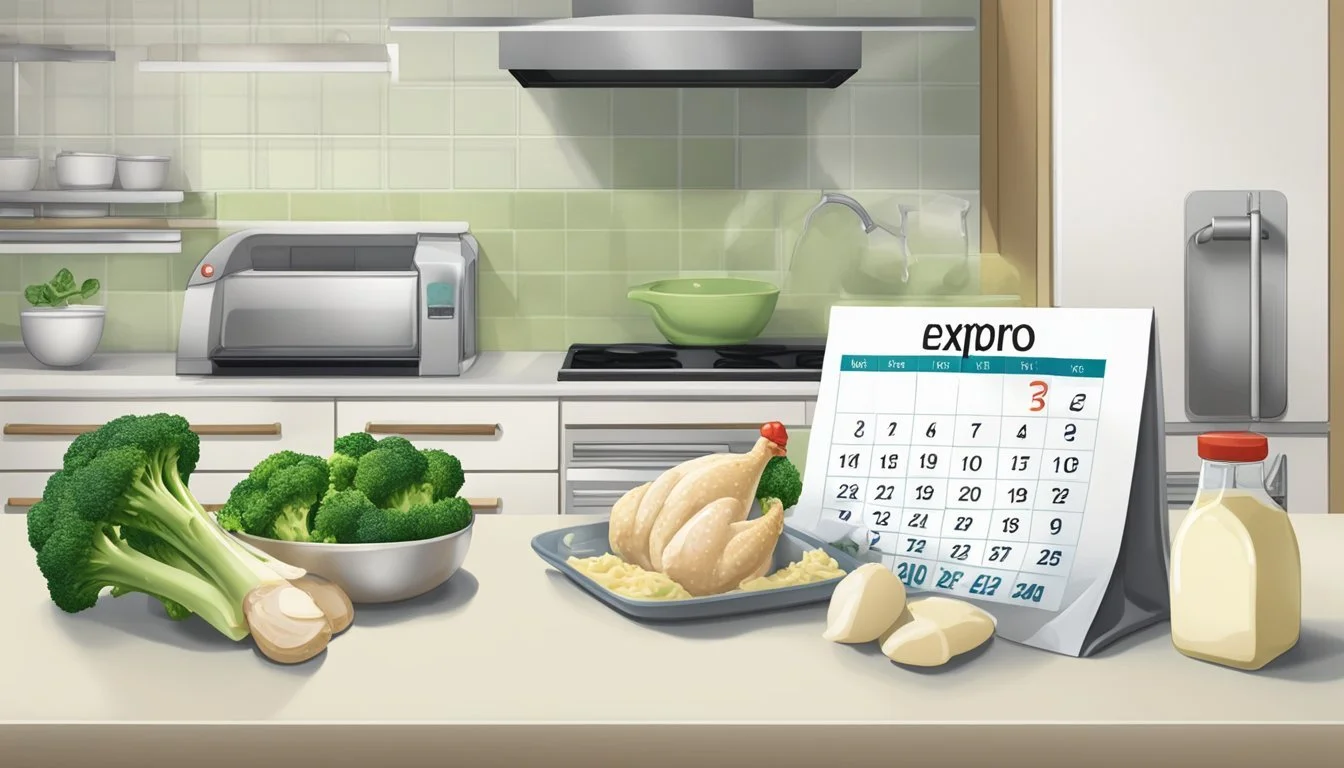How Long Does Chicken and Broccoli Alfredo Last?
Storage Tips and Guidelines
Chicken and Broccoli Alfredo is a delightful blend of creamy Alfredo sauce, tender chicken, and crunchy broccoli that many enjoy. For those planning their meals or mindful about food safety, it's crucial to know how long this dish can be stored. Properly stored in an airtight container, chicken and broccoli Alfredo can last for up to three days in the refrigerator.
Understanding the shelf life of your homemade chicken and broccoli Alfredo ensures your meals remain fresh and safe to consume. It's recommended to allow the dish to cool completely before transferring it to the fridge to maintain its quality. Additionally, while freezing is an option, be aware that the creamy Alfredo sauce may separate upon thawing, which can affect the texture.
Arming yourself with this knowledge not only maximizes the enjoyment of your meal but also ensures you don't waste any delicious leftovers. So, make the most out of your chicken and broccoli Alfredo and keep track of its storage time for the best culinary experience.
Overview of Chicken and Broccoli Alfredo
Chicken and Broccoli Alfredo is a classic Italian-American dish featuring tender chicken, crisp broccoli, and a creamy Alfredo sauce, creating a flavorful and satisfying meal. Essential to this dish are the right ingredients and an understanding of its nutritional benefits.
Ingredients Breakdown
Chicken and Broccoli Alfredo typically uses chicken breasts, which are pan-fried until fully cooked. Broccoli adds a vibrant color and a nutritious element to the dish.
The sauce is made rich and creamy with a combination of cream, Parmesan cheese, and garlic. These ingredients meld together to create a smooth texture.
Pasta, often fettuccine or penne, serves as the base, absorbing the creamy sauce and adding substance. Olive oil or butter may be used in the cooking process to enhance flavor.
Nutritional Information
The dish is a good source of protein due to the chicken breasts. Each serving typically provides around 20-30 grams of protein, supporting muscle growth and repair.
Parmesan cheese and cream contribute to the dish's fat content, which is essential for a creamy texture. However, these ingredients also add calories, making portion control important.
Broccoli adds dietary fiber, vitamins, and minerals, making the dish more balanced nutritionally. Overall, a typical serving of Chicken and Broccoli Alfredo can range between 500-700 calories, with fats providing a significant portion of this energy.
Preparation of Chicken and Broccoli Alfredo
Preparation of Chicken and Broccoli Alfredo involves using specific cooking techniques, seasoning and taste enhancements, and successfully combining ingredients for the best flavor.
Cooking Techniques
Cooking the chicken and broccoli correctly ensures that both ingredients reach the desired texture and flavor. Chicken should be cooked until golden and tender. This can be achieved by heating olive oil in a skillet over medium heat and cooking the chicken for 6-7 minutes or until it is no longer pink inside.
Broccoli can be prepared fresh or frozen. Fresh broccoli should be steamed for about 4-5 minutes until tender. Frozen broccoli requires only about 2-3 minutes in a microwave with a small amount of water. Ensure both ingredients are cooked to perfection before proceeding.
Seasoning & Taste Enhancements
Proper seasoning is vital for enhancing the taste of Chicken and Broccoli Alfredo. Common seasonings include salt, pepper, and Italian seasoning. Chicken can be seasoned with these before cooking, allowing flavors to penetrate the meat.
Garlic is essential for a rich, aromatic flavor. It should be sautéed in butter until fragrant, usually about 30 seconds. Using heavy cream in the Alfredo sauce adds a creamy texture, while adding grated Parmesan cheese results in a rich and flavorful sauce. Olive oil is another important ingredient that helps in melding flavors and adding a subtle fruity note.
Combining Ingredients for Optimal Flavor
Combining the ingredients efficiently is crucial for achieving the best results. After cooking the chicken and broccoli, it’s important to prepare the Alfredo sauce in the same skillet to retain flavors. Start by melting butter and sautéing garlic. Add flour and heavy cream, then whisk continuously until the sauce thickens.
Once the sauce is ready, return the cooked chicken and broccoli to the skillet. Stir well to coat them with the sauce, ensuring an even distribution of flavors. This method helps achieve a harmonious blend of textures and tastes, creating a cohesive and delicious dish perfect for any occasion.
Optimal Storage Practices
Proper storage of chicken and broccoli alfredo can help preserve its flavor and safety. Follow these guidelines to maintain quality, whether keeping it in the refrigerator or freezer.
Refrigeration Conditions
Leftover chicken and broccoli alfredo should be stored in an airtight container. Prompt refrigeration is crucial; refrigerate within two hours of cooking to prevent bacterial growth. Set your refrigerator to 40°F (4°C) or below.
When reheating, using a microwave-safe dish, heat in short intervals, stirring occasionally to ensure even warming. Expect maximum storage of three to four days under these conditions. Check for any signs of spoilage like unusual smells or discoloration before consuming.
Tips:
Store individual portions to avoid repeated reheating.
Label containers with dates to track freshness.
Freezing Instructions
For longer storage, freezing is an effective method. Once cooked, allow the dish to cool slightly before placing in freezer-safe containers or heavy-duty freezer bags. Remove excess air from bags to prevent freezer burn.
Frozen chicken and broccoli alfredo can last up to two to three months. When ready to eat, thaw it in the refrigerator overnight. Reheat thoroughly on the stove or in a microwave, ensuring it reaches an internal temperature of 165°F (74°C).
Tips:
Portion meals before freezing to make reheating simpler.
Freeze in flat layers for faster defrosting.
Shelf Life Determinants
The longevity of Chicken and Broccoli Alfredo relies on various factors, primarily related to storage conditions and the nature of its ingredients. Understanding these determinants can help prolong the dish’s freshness while ensuring safety and quality.
Factors Affecting Freshness
Several factors influence the shelf life of Chicken and Broccoli Alfredo. Storage Temperature plays a critical role. Keeping the dish refrigerated at 40°F (4°C) or less slows bacterial growth. Usage of airtight containers prevents moisture loss and contamination.
Ingredients also impact shelf life. Fresh broccoli florets and high-quality chicken last longer. The sauce, typically made with cream or milk, is susceptible to spoiling even under refrigeration. The presence of garlic and olive oil, common in the dish, has antimicrobial properties but does not significantly extend shelf life.
Signs of Spoilage
Identifying spoilage is crucial to avoid foodborne illnesses. Visual indicators like mold growth or discoloration on chicken or broccoli florets suggest the dish should not be consumed. Texture changes, such as a slimy or mushy feel, point to spoilage.
Odor is a reliable sign; a sour or off smell from the sauce or cream indicates bacterial activity. Taste deterioration can also occur before visible signs, so any unusual flavor should warrant caution. Monitoring these signs ensures the dish is consumed while safe and fresh.
Serving Suggestions and Pairings
Chicken and Broccoli Alfredo can be elevated with thoughtful accompaniments and the right beverages to create a delightful meal experience.
Accompaniments
Serve garlic bread alongside Chicken and Broccoli Alfredo for a crispy and flavorful addition. Freshly baked bread with a hint of garlic complements the creamy sauce and adds a satisfying crunch.
A light Caesar salad is an excellent pairing. The crisp romaine lettuce, parmesan cheese, and croutons provide a refreshing contrast to the rich alfredo sauce.
A caprese salad, featuring fresh mozzarella, tomatoes, and basil, can also add vibrant flavors and colors to the plate, balancing out the heaviness of the pasta dish.
For a simple yet effective garnish, sprinkle some fresh parsley or shaved parmesan on top of the Alfredo. These touches enhance the visual appeal and flavor of the dish.
Wine and Beverage Pairings
A well-chosen beverage can enhance the dining experience. A Chardonnay pairs well with Chicken and Broccoli Alfredo. Its buttery flavor complements the creamy sauce, while the acidity cuts through the richness of the dish.
For those who prefer red wine, a Pinot Noir offers a lighter, fruit-forward option that won't overpower the flavors of the Alfredo. Its subtle tannins work well with both the chicken and broccoli.
Non-alcoholic options include a sparkling water with a lemon twist, which provides a refreshing palate cleanser. An iced tea, particularly a lightly sweetened or unsweetened variant, can also be a good match.
For cheese enthusiasts, serving a small plate of assorted cheeses such as aged cheddar, gouda, or brie can be a delightful prelude or accompaniment to the meal.
These suggestions ensure the meal is both delicious and memorable.
Variations of the Classic Recipe
There are numerous ways to customize chicken and broccoli alfredo to suit different dietary needs and preferences. These modifications can range from substituting proteins to creating vegetarian and low-calorie versions, adding both variety and versatility to the dish.
Alternative Proteins
Replacing chicken with shrimp or salmon can offer a delightful twist. Shrimp needs minimal cooking time; sauté until they're pink. Salmon can be cooked in the same alfredo sauce until it flakes easily with a fork.
Other protein alternatives include turkey breast or lean pork cuts. These options keep the dish protein-rich while adding unique flavors.
Vegetarian Options
For a vegetarian approach, substitute chicken with zucchini or other vegetables. Zucchini can be spiralized or cut into chunks and sautéed until tender.
Additionally, firm tofu or tempeh can be used as protein replacements. Cook these in olive oil until they're golden brown and then mix them with the alfredo sauce and broccoli.
Low-Calorie Substitutes
Using milk instead of heavy cream significantly reduces the calorie content. Opt for skim or low-fat milk and thicken the sauce with a bit of flour or cornstarch.
Zucchini noodles or whole wheat pasta can replace traditional pasta to further cut down on calories. Both of these modifications maintain the dish's texture while making it healthier.







